QSC RAVE-520-AZ Owners manual
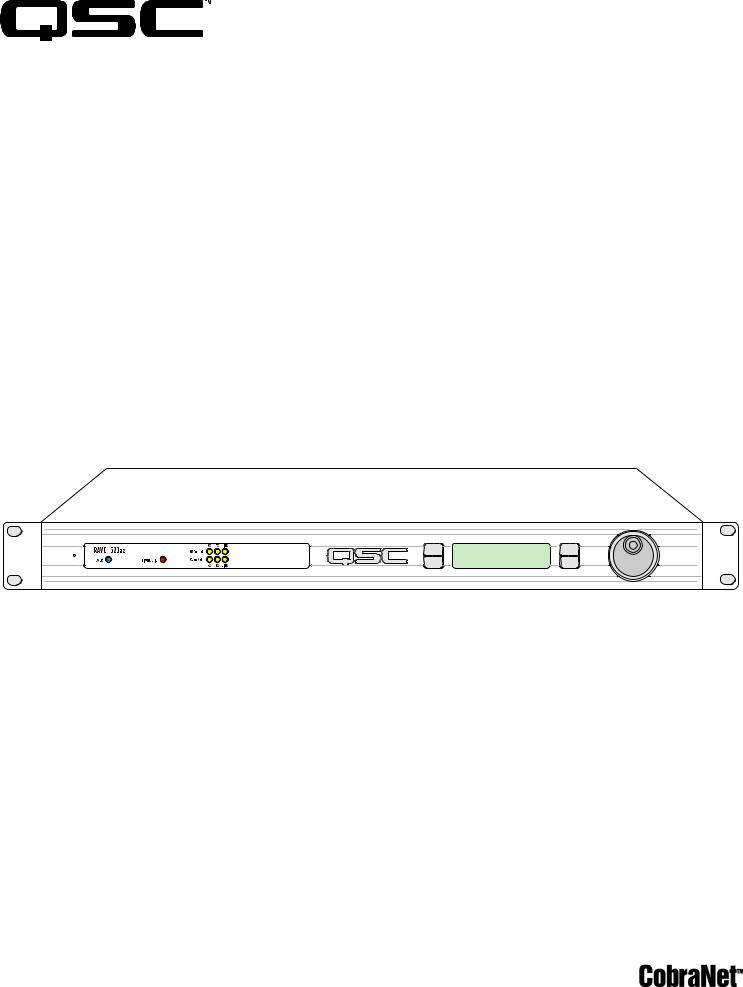
RAVE 520az
8 input CobraNet Enabled Signal Processor Hardware Manual
*TD-000153-00*
TD-000153-00 rev.A
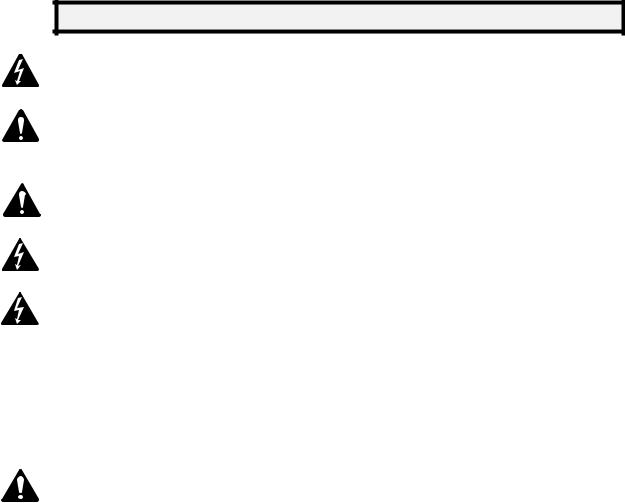
IMPORTANT SAFETY PRECAUTIONS & EXPLANATION OF SYMBOLS
The lightning flash with arrowhead symbol within an equilateral triangle is intended to alert the user to the presence of uninsulated “dangerous” voltage within the product’s enclosure that may be of sufficient magnitude to constitute a risk of electric shock to humans.
The exclamation point within an equilateral triangle is intended to alert the user to the presence of important operating and maintenance (servicing) instructions in this manual.
SAFEGAURDS
Electrical energy can perform many useful functions. This unit has been engineered and manufactured to assure your personal safety. Improper use can result in potential electrical shock or fire hazards. In order not to defeat the safeguards, observe the following instructions for its installation, use and servicing.
CAUTION: To reduce the risk of electric shock, do not remove the cover. No user-serviceable parts inside. Refer servicing to qualified service personnel.
WARNING: To prevent fire or electric shock, do not expose this equipment to rain or moisture.
1- Maximum operating ambient temperature is 50°C (122°F).
2- Never restrict airflow through the device fan or vents. Please insure that the air intake and exhaust vents are unobstructed.
3- When installing equipment into rack, distribute the units evenly. Otherwise, hazardous conditions could be created by an uneven weight distribution.
4- Connect the unit only to a properly rated supply circuit. The RAVE 520az is suitable for connection to 100 - 240 VAC, 47 - 440 hertz, with no special considerations other than the appropriate IEC power cord. 5- Reliable Earthing (Grounding) of rack-mounted equipment should be maintained.
LITHIUM BATTERY WARNING
THIS EQUIPMENT CONTAINS A NON-RECHARGEABLE LITHIUM BATTERY. LITHIUM IS A CHEMICAL KNOWN TO THE STATE OF CALIFORNIA TO CAUSE CANCER OR BIRTH DEFECTS. THE NON-RECHARGE- ABLE LITHIUM BATTERY CONTAINED IN THIS EQUIPMENT MAY EXPLODE IF IT IS EXPOSED TO FIRE OR EXTREME HEAT. DO NOT SHORT CIRCUIT THE BATTERY. DO NOT ATTEMPT TO RECHARGE THE NONRECHARGEABLE LITHIUM BATTERY.
FCC INTERFERENCE STATEMENT
NOTE: This equipment has been tested and found to comply with the limits for a class B digital device, pursuant to part 15 of the FCC rules. These limits are designed to provide reasonable protection against harmful interference in a residential installation. This equipment generates, uses, and can radiate radio frequency energy and if not installed and used in accordance to the instructions, may cause harmful interference to radio communications. However, there is no guarantee that interference will not occur in a particular installation. If this equipment does cause harmful interference to radio or television reception, which can be determined by switching the equipment off and on, the user is encouraged to try to correct the interference by one or more of the following measures:
-Reorient or relocate the receiving antenna.
-Increase the separation between the equipment and the receiver.
-Connect the equipment into an outlet on a circuit different from that to which the receiver is connected.
-Consult the dealer or an experienced radio or TV technician for help.
© Copyright 2004 QSC Audio Products, Inc. QSC® is a registered trademark of QSC Audio Products, Inc. “QSC” and the QSC logo are registered with the U.S. Patent and Trademark Office. All trademarks are the property of their respective owners.
2
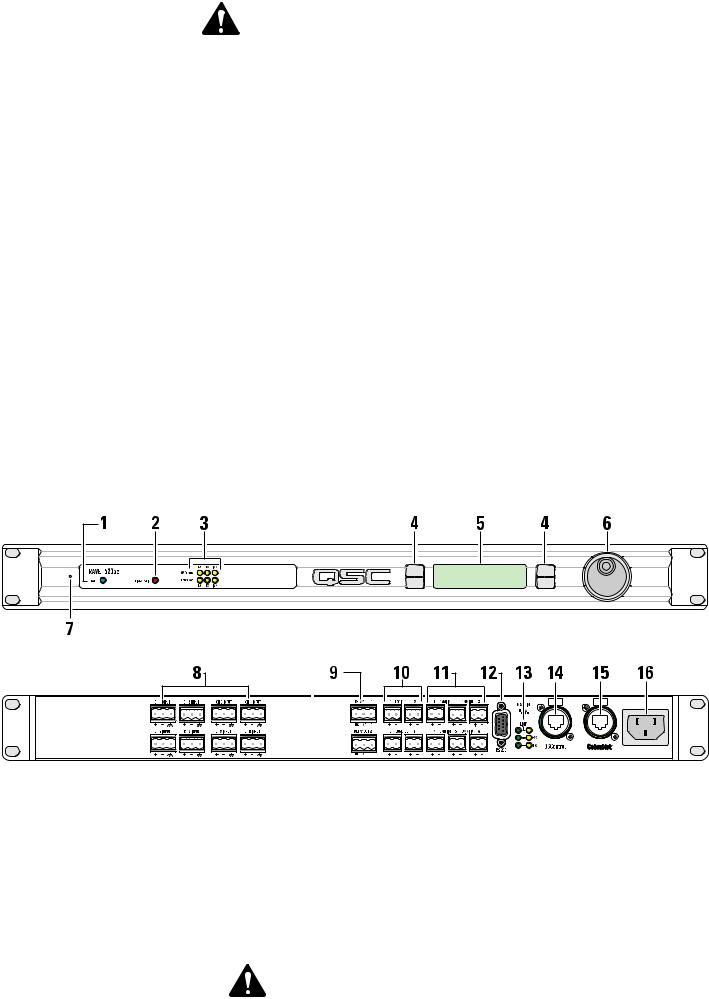
Don’t want to read the entire manual? Just
want to dig right in? Go to page 18....
Introduction
The RAVE 520az provides the digital audio transport and signal processing needed to distribute audio throughout an integrated functioning system. In conjunction with QSControl.net software, the RAVE 520az enables the user to design, test and deploy professional audio reinforcement and distribution systems ranging in size from one to hundreds of channels.
A standard Windows computer is the principle user-inter- face for controlling the overall RAVE/QSControl system. However, the RAVE 520az also offers a front panel interface for accessing critical functions.
A single QSControl server computer can support several clients running QSC's latest Venue Manager software. Thus, the sound system can be operated via several computers, roaming wireless laptops, tablets, etc., all at the same time, from anywhere a connection to the QSControl network is available.
The QSControl network can also be managed from a single computer running both the client and the server. Once all RAVE devices in a system are configured, a computer is no longer required on that system’s network. All basic functions of the RAVE 520az continue to operate with or without a control computer connected to the network.
Audio enters a RAVE 520az either through analog line inputs or from CobraNet source devices such as QSC's line of RAVE digital audio routers. Any combination of 16 CobraNet channels (selected from up to 4 bundles of 32 channels) can be routed into the 24 x 24 DSP engine. Any or all of the 24 DSP channels can also be routed to up to 32 CobraNet channels on the network.
Unlike other configurable DSP boxes, the intrinsic processing latency of the RAVE 520az is both short and fixed at 0.396 milliseconds. The delay does not change regardless of the DSP configuration, unless the configuration intentionally adds more delay.
1- Power indicator |
9- Relay outputs |
2- Diagnostic indicator |
10Logic outputs |
3- Network status indicators |
11Omni inputs |
4- Multi-function push buttons |
12- RS-232 port |
5- Display |
13Network status indicators |
6- Rotary select/accept knob |
14QSControl 10BaseT receptacle |
7- Safe Mode push switch (recessed) |
15CobraNet 100BaseTx receptacle |
8- Analog inputs |
16IEC power inlet |
See page 14 for detailed descriptions.
3
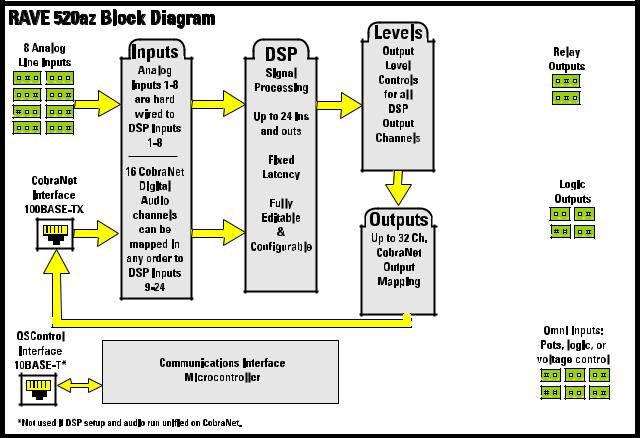
Introduction (continued)
The RAVE 520az also supports the new optional low-latency CobraNet feature that provides transport at only 2.66 milliseconds delay.
Both software and firmware can be easily updated over the network. In the future, QSC will be adding new capabilities to both RAVE and QSControl.net. Our latest code releases and access to up-to-date information on RAVE and QSControl.net are available at www.qscontrol.net. We invite you to visit us there.
We've applied our many years experience in supporting high-end installed sound with our previous system-building products such as RAVE, QSControl, CM16a, DSP-3, DSP-4, and DSP-30. The RAVE 520az brings all that technology together in one compact, powerful, easy to use system. We are confident that your new RAVE 520az will provide years of dependable service and we hope it will help you, the system designer and implementer, to express your creative audio system ideas.
Block Diagram
4
Introduction - Networking the RAVE 520az
The RAVE 520az has two RJ-45 network connection ports on the rear panel. One port is labeled "QSControl" and supports standard 10BASE-T Ethernet. The other port is labeled "CobraNet" and supports 100BASE-TX, also known as "Fast Ethernet". In the following we describe the use of these ports and show example network connection schemes.
The RAVE 520az supports two distinct kinds of network activity; the first is audio transport via CobraNet, and the second is DSP setup via QSControl.net. The user can choose to install one network for CobraNet traffic and a second separate network for QSControl traffic. We call this the "Two Wire Interface". Alternately, it is possible to run both DSP setup data and audio traffic over CobraNet via the CobraNet port. In this case the QSControl port is unused. We call this the "Single Wire Interface".
Under the most demanding real-time control conditions and when using the lowest latency CobraNet settings, users may experience better QSControl performance using separate networks, especially when displaying a great many real-time meters. For most applications, separate networks won't provide any discernible benefits and will of course cost more. We therefore recommend using the Single Wire Interface when running CobraNet.
Why CobraNet Needs Special Treatment:
Ordinary Ethernet traffic has no guaranteed time of delivery. Packets of information may arrive at their destination out of order and some may be delayed more than others. This is fine for E-mail and even for downloading MP3 files over the Internet. Everything ends up properly reassembled at the destination, but how long this takes will vary according to network loading, span, etc. In contrast, CobraNet is "real time" - it delivers audio with a minimal, consistent transmission delay. CobraNet is designed to use as much of conventional networking technology as possible while providing both guaranteed time of delivery and isochronicity - maintaining a phase-locked sample-accurate clock across the entire network. These requirements mean that ordinary unregulated Ethernet data cannot be freely mixed with CobraNet information. The two can coexist on the same wire, but only by adhering to the proper rules.
To learn more about CobraNet and appropriate network topologies, please visit http://www.qscaudio.com/products/network/ resources.htm and http://www.peakaudio.com/CobraNet/background.html.
Notes on Network Systems Design:
As with any communications system, the reliability and performance of a local area network is intimately related to the designer's skill and knowledge in implementing a topology that is robust, efficient and standards-compliant. Proper network design is even more critical in distributed multimedia systems. Therefore, it is important for the system designer to realize that some conventional network practices must be avoided. Although each network design is unique and may carry its own performance requirements, compliance to the following three points will assist in building an audio network that is trouble free and efficient.
First, audio and conventional data communications deliveries should not exist on the same LAN or VLAN. The exception to this is the RAVE 520az Single Wire Interface, which offers a solution for converging audio and QSControl.net onto the same LAN or VLAN. However, conventional communications, such as corporate networks, print services, e-mail and Internet access, should not exist alongside CobraNet audio and QSControl.net on the same LAN or VLAN. Further, CobraNet audio and QSControl.net data should not exist together on the same LAN or VLAN when implementing the Two Wire Interface. This is not to say that conventional communications cannot share the same network hardware with a RAVE 520az. In fact, common network hardware, such as managed Ethernet switches and media converters, can service both RAVE 520az products and conventional data communications equipment so long as the managed switch or media converter are partitioned into separate network domains. This is normally done by configuring a separate VLAN for each data type. (Some switches may allow individual port assignments or support partitions through DIP switch selection.)
Second, CobraNet audio must traverse either a repeater domain or a network switch domain. The point here is that the CobraNet port on a RAVE 520az must connect directly to, and only to, either a repeater LAN or a switched Ethernet LAN. Hybrid networks containing both repeaters and switches are not permitted on the audio segment. Connecting the CobraNet port to a repeater that is in turn connected to a network switch poses an illegal and non-compliant condition. We recommend always connecting the QSControl and/or CobraNet port(s) directly to network switch ports.
5
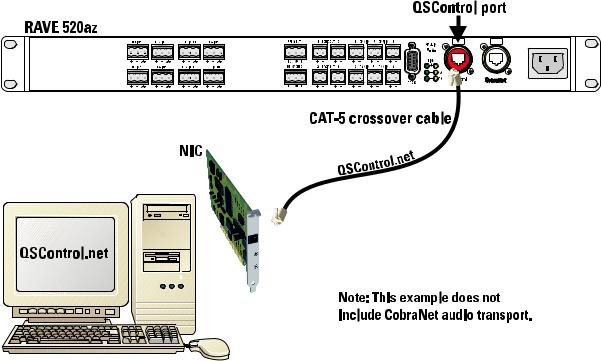
Third, the RAVE 520az and QSControl.net system are targeted at network switch deployments.
The consumer costs of Ethernet switches have continued to fall over the last several years and are now comparable with repeaters on a per port basis. In addition, the sophistication and scalability of network switches make them ideal for new installations. However, we do realize that designers may wish to add RAVE products to existing audio network installations that are built on repeater LAN topologies. This applies primarily to existing CM16a and RAVE networks. For this very reason we continue to support connectivity to network repeater hardware with the RAVE 520az. Support for network repeaters exist only with the Two Wire Interface. That is to say that the QSControl port and the CobraNet port must be connected to separate repeater LANs. Even when properly configured, audio channel capacity is severely limited and both audio and control network expansion is limited by the respective wire speed of each segment. In other words, scalability ceases to exist when bandwidth demands on the QSControl segment approach 10 Mbps and demand on the CobraNet segment approaches 100 Mbps. Obviously, we recommend taking advantage of switch network technology whenever possible.
It should be noted here that while the CobraNet port on a RAVE 520az is restricted to repeater LAN or switch LAN deployments, QSControl.net is a TCP/IP standards-compliant network system and therefore supports operation on network repeaters, switches and routers. When implementing the Two Wire Interface, the QSControl.net segment does not require a single topology data path and therefore repeaters, switches and routers may be assembled on the LAN in a hybrid fashion.
To learn more about network design rules and system compliance visit the QSC network resources page at http://www.qscaudio.com/ products/network/resources.htm. To learn more about CobraNet design requirements and to obtain the CobraCAD system design utility visit the Peak Audio website at http://www.peakaudio.com/CobraNet/Network_Design.html.
All of this may seem daunting if you are new to networking. However, it all boils down to connecting a few simple cables between various networking devices. Most of the time it "just works". QSC helped pioneer CobraNet with our RAVE ™ products and there are hundreds of installations all over the world, in theme parks, hotels, stadiums - everywhere. They run hum-free, sound great and are very reliable.
The following examples will help get you started, but they just scratch the surface of what can be achieved with advanced networking…
Example #1 - QSControl.net X-over mode:
This is the simplest connection you can make between the RAVE 520az and your computer. You use a CAT-5 crossover cable connected between the RAVE ‘s QSControl port and your computer's Network Interface Card, (NIC). No network switch is required. With QSControl.net server and client software installed and running on your computer, you will be able to completely set up your RAVE 520az.
6
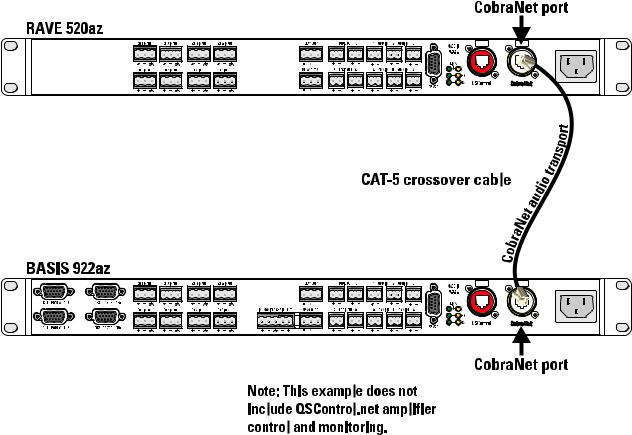
Example #2 - CobraNet X-over mode:
This is the simplest connection you can make between a RAVE 520az and a “destination” product such as the BASIS 922az/902zz/904zz or the RAVE 522aa.The RAVE 520az is the audio “source” in this example. You use a CAT-5 crossover cable connected between the CobraNet ports of each unit. No network switch is required. This connection allows audio to pass from the RAVE 520az to the BASIS/ RAVE unit over CobraNet.
Combining example 1 and 2 lets you setup one unit at a time, much as you would have to do using a point-to-point RS232 connection, while passing audio between them, all without a network switch. However, you would have to physically connect your computer first to one unit and then to the other. With this elementary connection you don't have a true network. It is like making RS-232 connections - except that performance is better.
All the other examples are of proper networks and all require a network switch. On a proper network, you have direct access to all RAVE/BASIS units all of the time without having to physically switch between them. You still get the great performance of TCP/IP over Ethernet. (And we believe QSC's advanced networking software provides the best performance of any networked audio control system available today, including Ethernet based systems from competitors.)
7
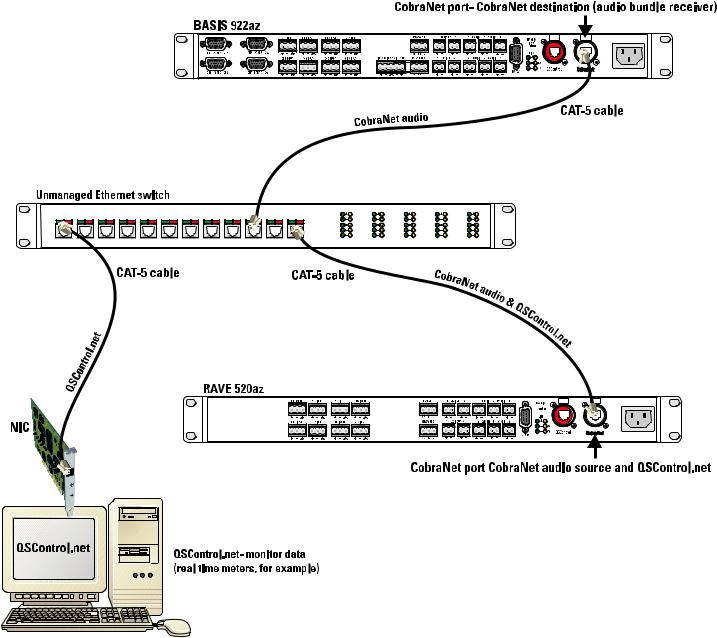
Example #3 - Single Wire Interface:
Here all QSControl and CobraNet traffic shares the same single CAT-5 cable between the RAVE 520az and an unmanaged Ethernet switch. The QSControl.net system manages traffic flow efficiently and reliably so that all audio and control data is delivered to its appropriate destination anywhere on the network. This configuration works well when CobraNet audio deliveries are point to point. Though the example shows only one RAVE 520az and one “audio destination” product (such as the BASIS 922az) as many devices may be connected as there are available switch ports. All RAVE/BASIS units will be able to communicate simultaneously with the computer. All will have CobraNet audio output capability, with the exception of source-only devices like the 520az. Switches can be connected to other switches to build larger networks; all of the normal networking principles apply. (Note: there must be at least two CobraNet devices online (one source and one destination) for any data to come out of the CobraNet port.).
8
